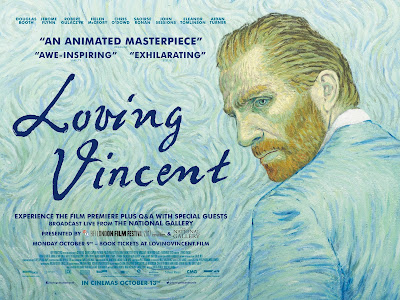Loving Vincent (2017) Starring Douglas Booth, Robert Gulaczyk, Jerome Flynn, Saoirse Ronan, Helen McCrory, Chris O'Dowd, John Sessions, Eleanor Tomlinson, Aidan Turner. Directed by Dorota Kobiela, Hugh Welchman. Screenplay by Dorota Kobiela, Hugh Welchman, Jacek Dehnel. Produced by Hugh Welchman, Ivan Mactaggart, Sean Bobbitt Run Time: 91 minutes. Polish/UK Color/BW Animated, Live Action, Biography
On July 27, 1890, at age 37, Vincent Van Gogh, a painter of little renown during his lifetime, shot himself in the chest with a 7mm Lefaucheux à broche revolver. There were no known witnesses, but the incident took place either in a cornfield or a barn. Mortally wounded, Van Gogh managed to make it back to his room, where he would die approximately 30 hours later. He would be visited by two doctors, Doctor Mazery and Doctor Gachet. While neither man was a surgeon, they made Van Gogh as comfortable as they could. Vincent's brother Theo came to visit, but before too long, Van Gogh grew weak and died.
These are the events that propel Loving Vincent, a new film with a very new technique. While originally shot as a live-action film, every frame has been painted over in oil in the impressionist style of Van Gogh.
 |
| From the film's website, showing the post-production of turning the live-action film into 65,000 oil painted frames. |
A year after Van Gogh's death, the postmaster of Saint-Rémy, Joseph Roulin (Chris Dowd), discovers a letter that the late artist had sent to his brother and sends his son, Armand Roulin (Douglas Booth), to find Theo, not realizing the brother is also dead. Armand, who starts out grudgingly, turns into a detective as he researches the last weeks of the great artist's life.
While that might sound like an interesting endeavor on its own, it is the presentation that separates this film from anything else you have seen on the silver screen before. Armand's search takes you into the world of Van Gogh, which includes his work. We are treated to re-enactments of some of Van Gogh's more famous works, the subjects of which also include several of the main characters in this film. The colors are as vivid of Van Gogh's paintings, with black-and-white being used to simulate flashbacks detailing more about Van Gogh's life.
 |
| The actor Jerome Flynn playing Dr. Gachet, Van Gogh's painting of the doctor and his ultimate portrayal in the film. |
A lot of experimental films are only about the experimental quality of their productions at the expense of film basics like story and acting. Thankfully, this film is both experimental without losing the basics that make it an interesting film. The story is intriguing. Even if you're not an art lover, Van Gogh's life and death have been made into movies before, probably the most memorable being Lust for Life (1956) starring Kirk Douglas. This film sort of works as a companion piece to that film, taking up the story when that one ends.
 |
| An example showing the film's transition from live action to oil painting. |
The acting is also very good. More than voice work, the actors are actually the live models on which the painting is added. It's as if they were parts of a continuous painting that comes to life. Douglas Booth, an actor I had never heard of before, gives a very strong performance as the son who becomes intrigued with an artist he doesn't really know. Other standouts include Eleanor Tomlinson as Adeline Ravoux, the daughter of the innkeeper where the artist died. Saoirse Ronan plays Marguerite Gachet, not only the subject of one of Van Gogh's paintings, but also a possible companion to the older artist. Jerome Flynn plays her father, Dr. Gachet, the last doctor Van Gogh sought treatment from after leaving the Hospital in Arles supposedly cured. Everyone feels that they had some hand in the artist's decision to commit suicide.
 |
| Douglas Booth gives a strong performance as Armand Roulin. |
The sad news is that Loving Vincent is not an easy film to see. As with most art house films, it is not available in wide release. But the film is really worth seeking out. If you're not fortunate enough to see it in on a big screen, then you should be looking for it when it becomes available on home video or your favorite streaming service.


No comments:
Post a Comment